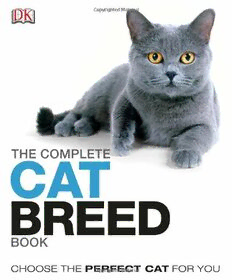
The Complete Cat Breed Book PDF
Preview The Complete Cat Breed Book
THE COMPLETE CAT BREED BOOK CHOOSE THE PERFECT CAT FOR YOU THE COMPLETE CAT BREED BOOK THE COMPLETE CAT BREED BOOK Consultant Editor DR. KIM DENNIS-BRYAN LONDON, NEW YORK, MELBOURNE, MUNICH, AND DELHI DORLING KINDERSLEY Senior Editor Paula Regan Project Art Editor Laura Roberts-Jensen Additional Design Tannishtha Chakraborty, Amy Orsborne Editorial Assistant Alexandra Beeden CONTENTS US Senior Editor Rebecca Warren US Editor Kate Johnsen Editors Lizzie Munsey, Steve Setford Jacket Editor Manisha Majithia Jacket Designer Laura Brim Jacket Design Development Manager Sophia Tampakopoulos DK Picture Library Claire Bowers, Claire Cordier, Emma Shepherd Commissioned Photography Tracy Morgan Database Rob Laidler, David Roberts Senior Producer, Pre-Production Ben Marcus 1 INTRODUCTION Producer Gemma Sharpe TO CATS Managing Editor Esther Ripley Managing Art Editor Karen Self Publisher Laura Buller What is a cat? 8 Art Director Phil Ormerod Associate Publishing Director Liz Wheeler Publishing Director Jonathan Metcalf Choosing the right cat 20 Consultant Editor Kim Dennis-Bryan Contributors Ann Baggaley, Jolyon Goddard, Wendy Horobin DK INDIA Managing Editor: Pakshalika Jayaprakash Senior Editor: Sreshtha Bhattacharya Editors: Antara Moitra, Nandini Gupta Assistant Editor: Archana Ramachandran Managing Art Editor: Romi Chakraborty Senior Art Editor: Govind Mittal Art Editors: Mahipal Singh, Amit Varma Assistant Art Editors: Tanvi Sahu, Tanvi Nathyal Design Consultant: Shefali Upadhyay Picture Researcher: Sakshi Saluja DTP Manager/CTS: Balwant Singh DTP Designers: Mohammad Usman, Sachin Singh, Vishal Bhatia Production Manager: Pankaj Sharma First American Edition, 2013 Published in the United States by DK Publishing 375 Hudson Street New York, New York 10014 13 14 15 16 10 9 8 7 6 5 4 3 2 1 001 - 185340 - May/13 Copyright © 2013 Dorling Kindersley Limited All rights reserved Without limiting the rights under copyright reserved above, no part of this publication may be reproduced, stored in or introduced into a retrieval system, or transmitted, in any form, or by any means (electronic, mechanical, photocopying, recording, or otherwise), without the prior written permision of the above publisher of the book. Published in Great Britain by Dorling Kindersley Limited. A catalog record for this book is available from the Library of Congress. ISBN 978-1-4654-0851-8 DK books are available at special discounts when purchased in bulk for sales promotions, premiums, fund-raising, or educational use. For details contact: DK Publishing Special Markets, 375 Hudson Street, New York, New York 10014 or [email protected] Printed and bound in China by Leo Paper Products Ltd Discover more at www.dk.com 2 CATALOG 4 HEALTH AND OF BREEDS BREEDING Shorthairs 26 Health 238 Longhairs 134 Inherited disorders 244 Responsible breeding 246 GLOSSARY 248 3 CARE AND INDEX 250 ACKNOWLEDGMENTS 256 BEHAVIOR Preparing for arrival 202 First days 206 Food and feeding 212 Handling your cat 216 Socializing your cat 218 Indoors or outdoors? 222 Cat communication 224 The importance of play 226 Grooming and hygiene 228 Training your cat 232 Behavior problems 234 NS T O A I T C C O U T D O R T N I 8 INTRODUCTION TO CATS WHAT IS A CAT? The domestic cat is now the world’s most popular pet, but cats were not always tame. The relationship between humans and cats began in the Near East about 10,000 years ago, when cats killed the rodents that ate grain stored in towns and villages. They were kept as pets in Egypt from about 2000 BCE, but the different Cats are fast-moving breeds have only been created over the last hundred years or so. natural athletes Evolution of the cat The most recent cats to evolve include the lynxes (US and The family history of the domestic cat goes way back in time, Europe), the bobcat (US), the leopard cat (Southeast Asia), to long before the first humanlike primates walked the Earth. and the wildcats (Africa, Europe, and Asia). The domestic cat All cats—from tigers, jaguars, and other big cats to smaller is descended from the African wildcat, and it is generally lynxes and ocelots—belong to the family of mammals called considered to be a wildcat subspecies. Felidae, which contains 41 living species. The first catlike carnivores appeared around 35 million years ago. Fossil Domestication evidence suggests that modern felids arose in Asia about 11 In the Near East, about 10,000 years ago, humans began million years ago. However, the big cats we know today, such growing cereal crops and storing grain for the first time. as the lion, did not evolve until much later, between 4 and 2 They found that rats and mice would get into their stores million years ago, when a drier, warmer climate gave rise to and eat the grain. However, the rodents themselves were open habitats and herds of soft-skinned grazing animals. eaten by small predators, such as the African wildcat. The athletic build of big cats was ideal for catching such prey. Soon a relationship between cats and humans developed: Less agile cats, such as the sabre-tooths, gradually died out. the cats had a ready supply of food in the rodents that THE CAT FAMILY ■ This diagram shows the relationship between the domestic cat and some of the other members of the cat family—the Felidae—based on An experimental genetic evidence. The closer a witChr odsosminegs tsiecr cvaatlss bthreee Cda krancoawtn is a tsh e cat is to the domestic cat on produced the product of breeding this diagram, the more similar Savannah breed. caracals with their genetic makeup. domestic cats. ■ All Felidae are carnivores— they eat exclusively meat and could not survive on a plant-based diet. ■ Though they vary in size, most cats share some physical characteristics—they have lithe, muscular bodies, large eyes, and retractable claws, and most have tails that measure up to half of their body length. Tiger Serval Caracal Ocelot & relatives
